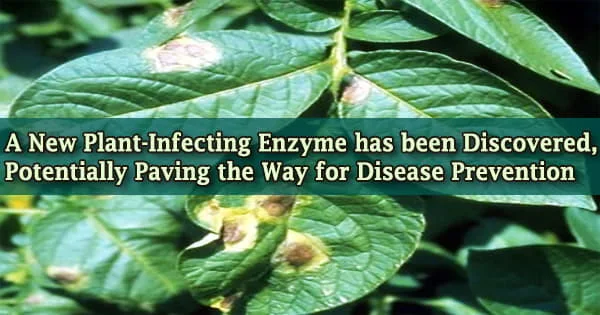Scientists have discovered previously unknown ways for crop diseases to get through plant cell walls, paving the way for the development of effective disease management technology.
The latest study, which was published in Science, describes a family of enzymes identified in the Phytophthora infestans bacteria. Enzymes catalyze (speed up) chemical reactions; in some situations, enzymes can make a chemical reaction millions of times faster than it would be otherwise.
Crop infections can use the enzymes to destroy pectin, a major component of plant cell walls, allowing them to get through the plant’s defenses and infect it. To catalyze a specific reaction, an enzyme will interact with only one sort of chemical or combination of molecules, referred to as the substrate.
Enzymes have a critical part in fungal plant pathology, and they are involved in both exterior and internal interactions. Plants developed a variety of defense systems to thwart the spread of fungal diseases. They created mechanical barriers out of lignin, suberin, and callose, as well as phenols, chinons, alkaloids, and other low-molecular-weight antimicrobial chemicals.
One of the most essential mechanisms in plant defense is the increased synthesis and activity of certain enzymes. These enzymes are found in a variety of isoform and are involved in the manufacture of defense chemicals or have antibacterial activity directly.
The active site of the enzyme is the only part of the enzyme that binds to the substrate. The active site is a groove or pocket created by the protein’s folding structure. Some proteins bind to the proteases of fungus and insects, inhibiting their activity.
Endogenous cues such as salicylic acid, abscisic acid, systemin, methyl jasmonate, and ethylene induce the creation of these inhibitors. Oligouronides, which are generated by insects and diseases, are involved in the regulation of their synthesis. Through systemic acquired resistance, they bind with receptors in cells and start the signaling cascade of this defense mechanism.
These new enzymes appear to be important in all plant pathogenic oomycetes, and this discovery opens the way for potentially powerful strategies in crop protection.
Dr. Federico Sabbadin
The worldwide team of researchers, lead by biologists and chemists from the University of York, discovered a new class of pectin-attacking enzymes known as LPMOs. The researchers also demonstrated that blocking the gene that encodes this enzyme prevented the infection from infecting the host.
Plant infestant is known to produce potato late blight, a severe plant disease that resulted in widespread hunger in Europe and over a million fatalities in Ireland during the 1840s, dubbed “The Great Famine.”
Plant infection continues to devastate worldwide crop output to the tune of billions of dollars each year, posing a serious danger to global food security. The discovery of this novel gene may pave the way for new approaches to protect crops against this key group of viruses.
Active plant defense mechanisms are complex and include responses such as plant cell death (HR), induction of the phenylpropanoid pathway and lignin synthesis (lignification), accumulation of phytoalexins, synthesis of hydroxyprolinerich glycoproteins (HRGP), and enzymes that degrade fungal walls (chitinases, glucanases), and elicitation of volatile compound production.
Lead author on the report, Dr. Federico Sabbadin, from the Biology Department’s Centre for Novel Agricultural Products (CNAP), at the University of York said: “These new enzymes appear to be important in all plant pathogenic oomycetes, and this discovery opens the way for potentially powerful strategies in crop protection.”
“The result of interdisciplinary collaborations between biologists and chemists at York, plant pathologists at the James Hutton Institute, and genomicists at CNRS, with invaluable molecular insights from Professor Neil Bruce (CNAP) and Professors Gideon Davies and Paul Walton in the Department of Chemistry at York,” said Professor Simon McQueen-Mason, also of CNAP.
The study is part of the New Enzymatic Virulence Factors in Phytophthora infestans initiative, which will run from 2021 to 2025 and is funded by a £1 million grant from the UK Research and Innovation’s Biotechnology and Biological Sciences Research Council (UKRI).
















